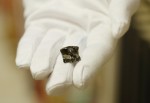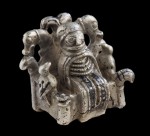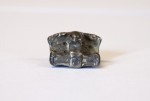 A very rare and very tiny chair-amulet from the Viking era has been discovered on the Danish island of Lolland. Metal detectorist Torben Christjansen, whom you might recall from the killer Thor’s Hammer amulet he discovered in 2014, found it in a field near Nybølle on the west side of the island. He had scanned the field before, lured by its black soil which is sometimes and indication of ancient activity, and found 65 objects, but he’d never seen anything like this little piece. Christjansen brought the artifact to Anders Rasmussen, curator at Museum Lolland-Falster, who identified it as a Viking chair-amulet.
A very rare and very tiny chair-amulet from the Viking era has been discovered on the Danish island of Lolland. Metal detectorist Torben Christjansen, whom you might recall from the killer Thor’s Hammer amulet he discovered in 2014, found it in a field near Nybølle on the west side of the island. He had scanned the field before, lured by its black soil which is sometimes and indication of ancient activity, and found 65 objects, but he’d never seen anything like this little piece. Christjansen brought the artifact to Anders Rasmussen, curator at Museum Lolland-Falster, who identified it as a Viking chair-amulet.
 No larger than a fingernail, the amulet depicts a wide chair with an abstract figure seated on it. On either side of the back of the chair are two smaller figures meant to represent ravens. The figure may be Odin, who according to an Icelandic saga from the 13th century, sat on a great chair named Hlidskjalf and observed our mortal goings-on from there. He would send his two ravens, Hugin and Munin, to explore the world and report back on what they’d seen during their voyage.
No larger than a fingernail, the amulet depicts a wide chair with an abstract figure seated on it. On either side of the back of the chair are two smaller figures meant to represent ravens. The figure may be Odin, who according to an Icelandic saga from the 13th century, sat on a great chair named Hlidskjalf and observed our mortal goings-on from there. He would send his two ravens, Hugin and Munin, to explore the world and report back on what they’d seen during their voyage.
 Only 15 or 20 chair-amulets have been found in Scandinavia, and just two of them in Denmark. One was found in Hedeby, an important Viking trade center now just over the Danish border in Schleswig-Holstein, Germany. The other at Lejre in Zealand in 2009. They have differences in design but all date from the late 10th and early 11th centuries. The amulets from Hedeby, Lejre and Nybølle are also quite different, but they share one thing in common. Two things, actually: the clearly identifiable ravens on the back of the chair.
Only 15 or 20 chair-amulets have been found in Scandinavia, and just two of them in Denmark. One was found in Hedeby, an important Viking trade center now just over the Danish border in Schleswig-Holstein, Germany. The other at Lejre in Zealand in 2009. They have differences in design but all date from the late 10th and early 11th centuries. The amulets from Hedeby, Lejre and Nybølle are also quite different, but they share one thing in common. Two things, actually: the clearly identifiable ravens on the back of the chair.
 The ravens strongly suggest that the shape in the chair represents Odin and the Lejre amulet, which is larger with more detailed carving, certainly features Odin. So it’s a reasonable assumption that Odin is sitting in this chair too, but it’s so amorphous a shape it could represent another character from the Norse mythology, an animal or perhaps another deity naughty enough to keep Odin’s seat warm for him.
The ravens strongly suggest that the shape in the chair represents Odin and the Lejre amulet, which is larger with more detailed carving, certainly features Odin. So it’s a reasonable assumption that Odin is sitting in this chair too, but it’s so amorphous a shape it could represent another character from the Norse mythology, an animal or perhaps another deity naughty enough to keep Odin’s seat warm for him.
 The area where the amulet was found has proven to be rich with Iron Age and Viking artifacts; jewelry, coins, rune stones and silver hoards have all been found near where the amulet was discovered. Archaeologists believe that Lolland, while not the large trade center that Hedeby and Lejre were in their medieval heyday, must have been very wealthy and prosperous for centuries.
The area where the amulet was found has proven to be rich with Iron Age and Viking artifacts; jewelry, coins, rune stones and silver hoards have all been found near where the amulet was discovered. Archaeologists believe that Lolland, while not the large trade center that Hedeby and Lejre were in their medieval heyday, must have been very wealthy and prosperous for centuries.
The amulet is heading to the National Museum where it will be examined by experts to determine whether it should be declared treasure trove (it will be). The finder will be compensated based on the valuation of the piece and then the local museum, in this case the Museum Lolland-Falster, will be given the amulet for study and display.